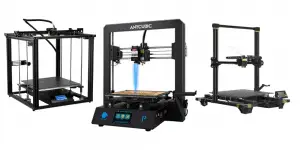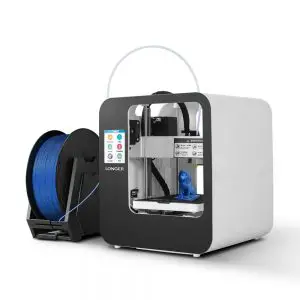Continuing our trend of low-priced starter 3D printers, today we will break down the features, pros and cons, and customer support behind the Monoprice Select Mini 3D printer, V2. Founded in 2002, Monoprice sells an array of consumer electronics. A Monoprice 3D printer, typically, will last a long time, get the job done, and have enough extra features to keep things interesting.
The Monoprice Select Mini V2 3D printer is ideal for students and others just starting out with 3D printing. The price is reasonable for all the features the printer offers. Let’s look at the specs for this fun printer, pulled from the Monoprice product page to ensure accuracy.
Monoprice Select Mini V2 Technical Specifications
- Max Print Size: 120 x 120 x 120 mm (4.7 x 4.7 x 4.7 inches)
- File Format: gcode, but can convert from .STL or .OBJ.
- Supported Filament Types: ABS, PLA, conductive PLA, wood/metal composites, dissolvable PVA.LA/PLA.
- Filament Diameter: Industry standard 1.75 mm.
- Printer Speed: max of 55 mm per second.
- Extruder: one single nozzle type, can reach up to 250 degrees Celsius (482 Fahrenheit).
- Extruder Diameter: 0.4 mm
- Printing Plate: heated up to 60 degrees Celsius (140 Fahrenheit).
Design and Features
The Select Mini 3D V2 has an open frame design. We would say that it looks a little like a hybrid of a lab-calibrated digital scale and a mobile X-ray machine. We have looked at quite a few open-frame desktop printers, and we can’t think of one that would be easier to observe, maintain, and troubleshoot. The open frame lends itself well to showing kids, students, and first-time users how this type of printer works as they watch the extruder putting down layers on the build plate. Though the extruder gets hot, there is little chance of injury if safety rules are observed. This includes not removing the piece of insulating tape that comes on the extruder when you open the package.
This printer is compact–it is designed to sit on a desktop or counter. Dimensions are 13.5 by 11.3 by 7.5 inches (height, width, and depth). In a classroom or teaching lab, you could place several of the printers on a workbench and let students print their designs without having to wait a long time. An external spool holder, included in the box, clips to the outside of the printer.
One of the quirks of the open frame is that the build plate has no protection. It is made of aluminum, durable enough but not destruction-proof. So you’ll want to make sure the printer is level at all times, and far from the edge of your work surface. This makes it less prone to falls, which could brick the build plate. You will also want always to keep tape on the build plate, and purchase an extra roll (not included) for when the factory tape degrades as tape does.
One small issue that has come up with a few users is that the included AC power adapter was not very durable. For more than one user, it quit working within a couple of days. Luckily, AC power cords are plentiful and cheap. We would always suggest keeping an extra one on hand just in case. Chances are, however, that you won’t need to use it.
Features of this Monoprice 3D printer include an LCD screen with buttons to the side, as well as connectivity with Micro USB, Wi-Fi, and MicroSD card devices. There are no color choices besides the basic, institutional-looking black and white.
Printing with the Monoprice Select Mini 3D printer
The heated print bed helps the print stick together, keeping the layers cohesive. Also, the extruder nozzle is all metal to help prevent the filament from clogging. These are both improvements over the original Maker Select Mini, which was one of the first equitable priced starter models to become available. The aluminum used in the build plate also helps with coherency, and even makes the finished print easier to take off without sticking.
Max resolution for the printer is 100 microns, and the build area is a 4.7 inch cube. These are not outstanding specs but are keeping in line with similar less expensive, low volume 3D printers.
With the highest extruder temperature being 230 degrees, you can use more types of filaments than you can with comparable printers. Some of the most high end, cutting edge filaments will not work, though, as they have higher melt points.
When it comes to printing, you have some choices, which is a nice touch for such an inexpensive unit. You can print from a USB drive, a micro SD card, or a mobile app provided by Monoprice. That’s to send the file to print. Print settings are all controlled from the LCD screen on the printer. You can use slicer programs on your desktop or laptop, but those programs are mostly open source and did not originate with Monoprice. If you use Cura, many of the features and programs are attuned to Monoprice printers, since the products are so popular.
When you get the printer, it comes with several practice models loaded on an SD card. You’ll want to design your own, with or without help, to see how the printer performs when you are the one providing all the info. Print quality is consistently good, even with irregularly shaped objects. Some details and sharp edges won’t translate, but that is to be expected with a low-cost printer. The printer can largely handle different shapes of objects with no problem at all.
Packing and Assembly
When you open the box, the first thing you may notice is how heavy the Monoprice Select Mini is for it’s size. Weighing in at 14.1 pounds you’ll find that most of its weight is because it is largely made of metal. It makes the printer steady and helps prevent warping, but also makes it harder to lift than similar compact, open frame 3D printers.
Besides the printer, the package contains:
- Filament rack
- Plastic scraper
- USB cable
- Micro SD card
- Allen key for assembly
- AC power cord and adapter
Once you unbox the printer and accessories, assembly is a snap. You plug the printer in, level it with on-screen helps, and rely on the factory calibration. You can go from never having used a 3D unit to making your own creations in an hour or less. Monoprice made this printer with students and beginners in mind, although the low print volume makes it unsuitable for large public school classrooms.
The filament rack has to be inserted, and the power cord snapped in place, and that is the only assembly needed before you can adjust the extruder height. The manual walks you through how to do that. You control extruder temperature with a wheel, and the printer screen helpfully tells you which temperature is right for each type of filament. Installing the filament spool is just as easy, and all steps are illustrated in the manual with photographs, not drawings.
Support
Monoprice is a company worth about $120 million a year, which is still small enough to provide individualized customer service. If there are issues, you can chat with an agent via the website or send an email. The user’s manual doesn’t provide a phone number for Monoprice, but we were able to find one easily via Google.
The Monoprice Select Mini V2 is so effective and well-received that entire wikis and Reddit pages have sprung up, created by users who share tips and projects. You won’t find this in the user’s manual, but it is possible to hack and upgrade the printer. There always seems to be some talk around augmenting 3D printer capabilities. We strongly suggest that you learn the basics and get a good grasp of coding before you try any homebrew enhancements. A beginner can easily damage the firmware and void the warranty, leaving the printer bricked or in need of expensive repairs.
Monoprice Select Mini V2 Pros and Cons
Pros
- One of the lowest priced 3D printers we have found yet
- Most of the setup and calibration done at the factory
- Can use more filament types than comparable printers
- No installation other than filament rack/spool
- Works with Cura for slicing, opening new possibilities
- Layer cohesion is good, even with odd shapes
- Come preloaded with starter projects on the Micro SD card
- Navigating the menu is easy and intuitive
Con
- Not a high volume/demand printer
- Limited application outside of the home, hobbyist makers, and classroom
- Power supply/adapter may glitch–keep a spare on hand
The Verdict
We are happy to recommend the Monoprice Select Mini V2 for the right applications. They include those just starting out with printers, although this would also make a nice, inexpensive project printer for someone who knows how to hack. The print quality is consistent, the print plate is heated, and the extruder runs hot enough for several types of filament.
Points of caution include the print plate, which can easily warp if you drop the printer. The power cord that comes with the printer is not the best. High end or exotic filaments won’t be available, because they melt too hot for the extruder. If you are using the printer with students, you will need to work in a small group or perhaps have more than one printer. Otherwise, would-be makers will have to wait in line to see their creations.
Last update on 2024-05-16 / Affiliate links / Images from Amazon Product Advertising API





